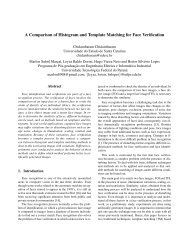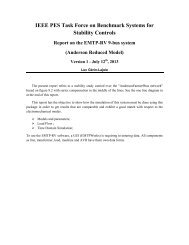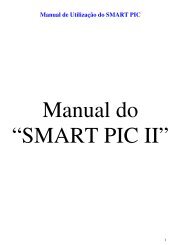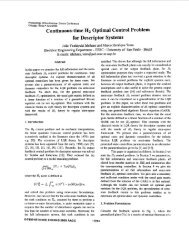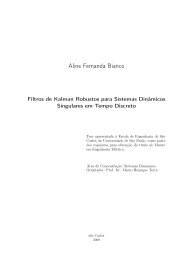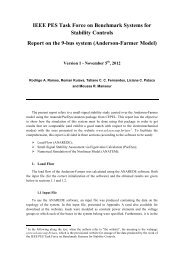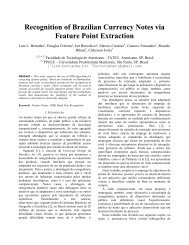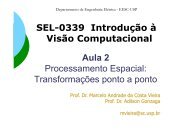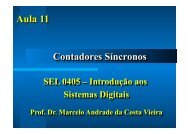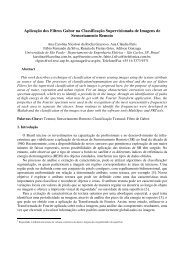III WVC 2007 - Iris.sel.eesc.sc.usp.br - USP
III WVC 2007 - Iris.sel.eesc.sc.usp.br - USP
III WVC 2007 - Iris.sel.eesc.sc.usp.br - USP
You also want an ePaper? Increase the reach of your titles
YUMPU automatically turns print PDFs into web optimized ePapers that Google loves.
<strong>WVC</strong>'<strong>2007</strong> - <strong>III</strong> Workshop de Visão Computacional, 22 a 24 de Outu<strong>br</strong>o de <strong>2007</strong>, São José do Rio Preto, SP.the developed technique. For each example shown the valuesof the parameters used will be given.Figure 6a represents a binary image of a pyramid. Figures6c and 6d illustrates different convergences of the initialcontour (figure 6b) when the value of the alpha parametervaries. This parameter controls the snake elasticity. Ahigher value (figure 6d) prevented the contour from expanding,while beta should be set to zero, as a higher value wouldprevent the snake from finding the sharp edge of the object.Once the desired contour is found, the vertexes identificationfor a quadrangular base pyramid is carried out. Theresulting contours and vertexes, as well the parameters usedin this experiment are illustrated in figures 6e and 6f.Notice that in the example illustrated above an anglevariation of 11 o has been employed. A higher value wouldprobably not be adequate in the identification of all its fourvisible vertexes.This technique, as well as being applied on binary images,can also be applied on gray <strong>sc</strong>ale images, as shownin figure 7, where a high-pass filter has been used to computethe the edge map.To illustrate the benefits of the proposed method, we performeda similar experiment with Hough transform technique[2], which is a traditional mechanism for line detection.Figure 8 illustrates the Hough Transform applied to theoriginal cube of figure 7a. Figure 8b represents the binaryimage of the original cube, while figures 8c, 8d, and 8e are,respectively, the Hough transform results for line segmentswith pixels quantities (threshold in Hough space) equal to5, 20, and 30.Although they have not been shown in the images, thevertexes can be easily calculated with the Hough transformtechnique, once each point in the Hough space represents aline. To calculate a vertex coordinate, the computation of theintersection points for each pair of lines would suffice. Thedifficulty, however, is to accurately define which, among allthe computed vertexes, truly belong to the cube. The difficultyin defining the correct vertex increases with the thresholdin Hough space. Although it can be trivial to find line intersections(possible vertexes) there is no clear indication ofwhich points actually are the real vertexes of the object.5. ConclusionsBy applying the active contour concept, this paper hasproposed an automatic edge and vertexes detection <strong>sc</strong>hemeto some geometric shapes that can be an aid device for imagebased modelling tools, such as Canoma.A survey on image-based modelling tools has been madeand no such functionality as that proposed in this article hasbeen found. This new approach turned out to be rather functional,specially for simple shape primitives such as cubesand pyramids. This is due to fact that the mechanism presentedembodies geometric information of the object andthe ability of the GVF snake to correctly converge to theoriginal object contour.Although the methodology is highly parameterized, wecan identify an adequate set of values to this parameters, accordingto the image type, so that the performance is satisfactory.Tests have also been carried out with Hough transform,but the results found were worst than those obtained withthe method proposed in this paper. Although the Houghtransform is an elegant line detection mechanism, no geometricalinformation on the object is provided. On the otherhand, in the method proposed such information comes fromthe edge map, needed to compute the snake.We must point out that this is not primarily a segmentationtool capable of finding occluded objects. We assumethat the <strong>sc</strong>ene is composed of a single object with little noisybackground. However, this work can be extended to includea pre-processing process tha could be used to segment morecomplex <strong>sc</strong>enes.References[1] V. Cantoni, L. Lombardi, M. Porta, and N. Sicard. Vanishingpoint detection: Representation analysis and new approaches.In Proceedings of the IEEE International Conferenceon Image Analysis and Processing, volume 11, pages90–94, 2001.[2] P. V. C. Hough. A method and means for recognition complexpatterns. US Patent, 1962.[3] M. Kass, A. Witkin, and D. Terzopoulos. Snakes: Activecontour models. International Journal of Computer Vision,1(4):321–331, 1987.[4] A. C. C. Machado, L. R. Galvo, T. A. Vanderlei, and W. Y. R.Santos. Uma ferramenta de extrao de bordas utilizando t-snakes. Revista Eletrnica de Iniciao Cientfica, 2002.[5] M. Oliveira. Image-based modeling and rendering techniques:a survey. RITA - Revista de informtica terica e aplicada,(2):37–66, 2002.[6] B. S. Pimentel. Segmentao de imagens mdicas utilizandomodelos de active contours. Avaiable in:¡http://www.lrvpa.dcc.ufmg.<strong>br</strong>/vision/snake/artigo.htm¿,Laboratrio de Viso Computacional e Robtica. Acessed in:10/08/05, 2000.[7] L. Stevens. Canoma - Manual do usurio. MetaCreationsCorp., 6303 Carpinteria Avenue, Carpinteria, CA 93013,1999.[8] C. Xu and J. L. Prince. Gradient vector flow: A new externalforce for snakes. In IEEE Proc. Conf. Comp. Vis. Patt.Recog. (CVPR), pages 66–71, 1997.[9] C. Xu and J. L. Prince. Snakes, shapes, and gradient vectorflow. IEEE Transaction on Image Processing, 7(3):359–369,March 1998.[10] O. A. Zuniga and R. M. Haralick. Integrated directionalderivative gradient operator. 17:508–517, 1987.79




